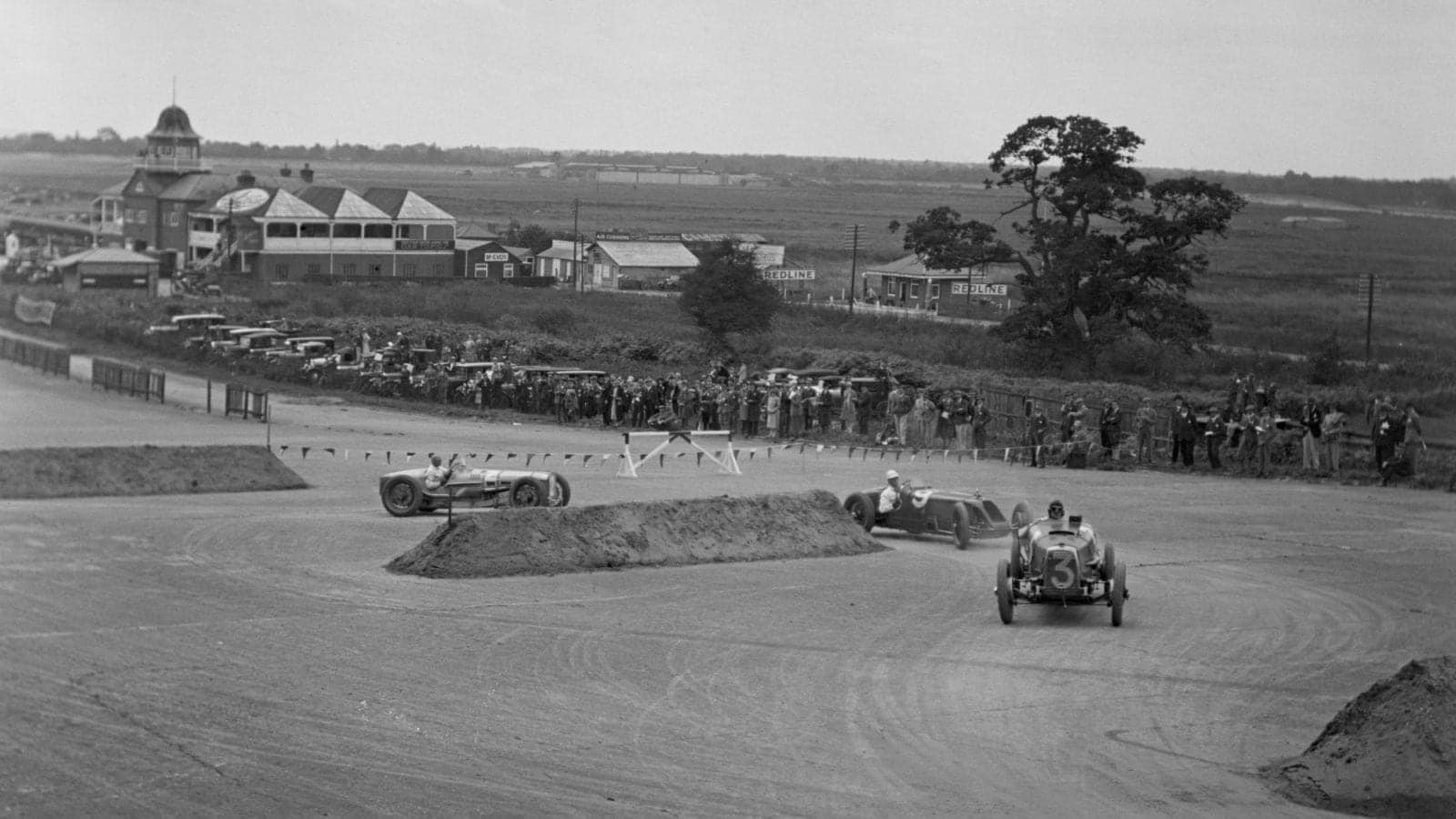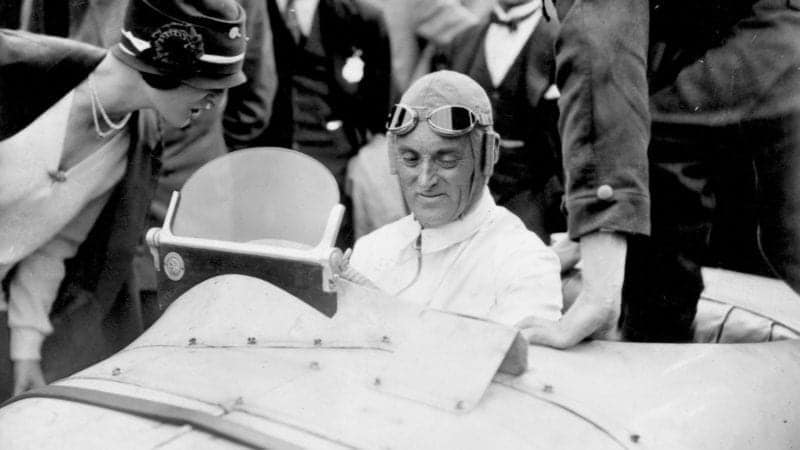The first British Grand Prix: 1926 Brooklands Great International Race

George Eyston leading Henry Segrave and Robert Benoist
G. Adams/Topical Press Agency/Hulton Archive/Getty Images
Great International Race held at Brooklands
A brighter scene than Brooklands on August 7th, 1926, would be hard to imagine; sunshine, dresses, sumptuous cars, grass, trees, advertisements, and lastly the little green and blue projectiles themselves, such is the picture retained in the mind, of this great event. One was impressed by the resemblance to a horse-racing meeting, even to the parade of cars burbling gently out to the distant starting line from the paddock, to the delight of the huge crowd, many of whom did not again have an opportunity of examining the vehicles at such close range. The antics of the mechanics when climbing in to accompany the drivers to the start, were most amusing, some of them only just retaining their precarious seats as the driver ” trod on the gas.”
At length the cars were lined up at the end of the finishing straight, and with commendable promptitude Mr. Ebblewhite’s little red flag was raised and dropped to the accompaniment of a crescendo of exhausts and the shrill whine of nine, no, twelve superchargers (the Delages each had two superchargers).
Almost at once the terrific acceleration of the Talbots became obvious, all three shooting to the front, and Divo, in particular, handsomely outstripping even his team mates. In an incredibly short time the competitors came screaming off the Byfleet banking, the three Talbots in the van, but, to everyone’s dismay, Moriceau’s car was seen to be in trouble. With wildly wobbling front wheels the car was gradually pulled over to the left of the track and stopped. It was then observed that the front axle had collapsed, allowing the front wheels to sag inwards in a most pathetic manner. There was no time to ponder over this misfortune, however (which naturally caused Moriceau to retire), for the rest of the field came snaking through the bends, Divo, Segrave and Benoist (Delage) leading, with the other two Delages at the tail end of the procession, and temporarily behind, the three British drivers, Campbell (Bugatti), Halford (Halford), and Eyston (Aston Martin), who completed the procession.
The first change in the order resulted in Senechal on the Delage overtaking Eyston, and this order was maintained for about six laps, during which time the three leaders, now in close formation, averaged 82 m.p.h.
Segrave’s Talbot exhaust pipe belched wicked yellow flames in the most ominous manner without apparently affecting his speed
At this early stage of the race several interesting facts were noted : Segrave’s Talbot exhaust pipe belched wicked yellow flames in the most ominous manner without apparently affecting his speed ; Senechal appeared to delight in violent skidding on all the corners, whereas all the other drivers restrained themselves from this amusing and destructive policy ; it was interesting to note that Segrave and Divo shot away from Benoist’s Delage on leaving the last sandbank, but owing to unreliable brakes and lack of faith in their front axles, they cut out much earlier than Benoist, approaching the bends, so that the Delage lost no ground to them on the whole lap.
Louis Wagner stopped on his third lap and fitted a set of new plugs to his Delage, an operation which he repeated several times during the next few laps. However, it seemed that the much-maligned sparking plug was once more not to blame, and the trouble was something deeper. To everyone’s surprise, Wagner was announced as retiring with feet burnt by his exhaust; surely Delage had not ignored their San Sebastian lesson? Actually, however, the hot exhaust pipe set fire to the body of the car, thus contributing to the causes of its withdrawal. About this time Divo also called at the pits for plugs, allowing Segrave to take the lead, which he held until the thirteenth lap, when he shed a tyre tread and stopped to change both back wheels.
Segrave’s stop gave the lead to Benoist, who had been quietly biding his opportunity in second place, and who continued to lap at 82-83 m.p.h. Senechal and Segrave, who had restarted, were running level, about two laps behind, in second and third positions respectively, followed by Halford, Campbell, Divo and Eyston in the order named.
An interesting feature at this period of the race was the ugly behaviour of Segrave’s front wheels on approaching the first corner. The axle appeared to judder badly, the wheels wobbled and sometimes locked, as though the brakes were seizing. Halford was very fast through the bends, swinging out wide just by the bridge and menacing the timekeeper’s box. His car appeared to roll somewhat. Very little change in the order took place during the next twenty laps ; Benoist changed his rear tyres without losing the lead, and Divo stopped now and again to carry out adjustments.

Malcolm Campbell finished second in his Bugatti 39A
G. Adams/Getty Images
Towards the 50th lap Segrave’s Talbot began to cough and splutter, at one time almost stalling by the last sandbank ; Segrave stopped to alter the mixture, but no great improvement was noticed. When the leader completed 50 laps the order was :
1 Benoist (Delage). 80.41 m.p.h. ; 2 Senechal (Delage) ; 3 Segrave (Talbot) ; 4 Halford (Halford) ; 5 Campbell (Bugatti) ; 6 Divo (Talbot) ; 7 Eyston (Aston Martin).
Shortly after this Eyston stopped to investigate the cause of overheating, and discovered a blown cylinder head joint and water pump trouble. After an attempt to repair matters he retired. A very creditable effort, when it is known that the engine was only installed two days before the race.
Segrave now began to stop on almost every lap, and was passed by Halford; thereafter he made spasmodic attempts to continue, but eventually retired ” before he broke everything.” Among other troubles, his car had been on fire at the pits, but was quickly extinguished.
The crowd now settled down to watch the extraordinary skids performed by Robert Senechal, who seems to delight in this method of cornering. One of the most exciting incidents of the race occurred at the second series of bends : Senechal was being closely followed by Div0, who was usually most unspectacular ; on the right hand turn Senechal skidded broadside, nearly stopping in front of Divo; in perfect time Divo executed an exactly similar skid, checking his car when it was parallel to the Delage; both cars then proceeded to turn, left on to the main track, where the same thing took place again, except that Div0 slipped past Senechal on the inside and stole a useful lead.
Dubonnet, an amateur, drove in his “gent’s natty suitings ” and hatless!
On another lap, the exuberant Senechal waved both his arms in the air in the middle of a very lurid skid, or, as the lay press stated, “Threw up his arms in despair.”
Malcolm Campbell now began to drive the Bugatti faster, and he and Halford changed places several times owing to replenishment stops; meanwhile Div0 seemed to have got over his troubles and was working up, eventually attaining third place after about 70 laps.
Benoist now began to lose ground, his engine was misbehaving and the old exhaust pipe trouble was recurring; however, he had a substantial lead, and in spite of a depot stop he was not displaced. Senechal was the next to suffer, as his pedals and floorboards began to scorch his feet. The race thus assumed a curious aspect. The three leaders were all in some form of trouble, while the two tail enders, Halford and Campbell, were running well; in spite of this, however, Div0’s Talbot was the fastest car running, although misfiring. On his 83rd lap Senechal stopped and leapt into a foot bath of cold water, and Wagner took his place in the Delage, getting away in company with Divo, who had stopped for replenishment.
It now appeared that the Halford stood a very good chance of winning, as it had been performing with such reliability, but it was not to be ; on its 83rd lap it stopped between the bends with a broken universal joint and caused Wagner, who was just behind, to take the middle arch of the bridge. Halford pushed back to the pits and retired.
Just before 90 laps Benoist came in to try and rectify various troubles, and Wagner took the lead on Senechal’s Delage. Benoist’s car was on fire, and spent some time at the pits, eventually restarting in the hands of Dubonnet, an amateur, who drove in his “gent’s natty suitings ” and hatless! Wagner was soon in trouble with his feet, and stopped every few laps to bathe them, but managed to retain an ever decreasing lead. Divo in the meantime stopped once more, and after many fruitless attempts to restart eventually gave up, thus eliminating the last British hope. Excitement rose to fever pitch during the last 15 laps, with Campbell gradually overhauling the crippled and flaming Delage driven by Dubonnet, who was evidently suffering greatly, tongues of flame belching from the bonnet. Both these cars, however, were catching up Wagner’s Delage, which kept on stopping on account of the driver’s feet. On the 102nd lap the Bugatti passed the Delage, thus securing second place, which it maintained to the end. Wagner was too far ahead to be caught, and eventually won at 71.61 m.p.h., a remarkably good speed considering the number of stops.
Malcolm Campbell (Bugatti), who only had three stops, finished second at 68.82, just in front of Benoist’s and Dubonnet’s red-hot Delage, which averaged 68.12 m.p.h.
Thus finished the greatest race ever seen at Brooklands; at the conclusion the Delage drivers had to be lifted out tenderly and have their feet treated for burns, Benoist incidentally announcing that unless the design was altered he would not drive again.
During the course of the race it was announced that the Stanley Cup for the fastest lap was won by Major Segrave, who covered one circuit at 85.99 m.p.h.
